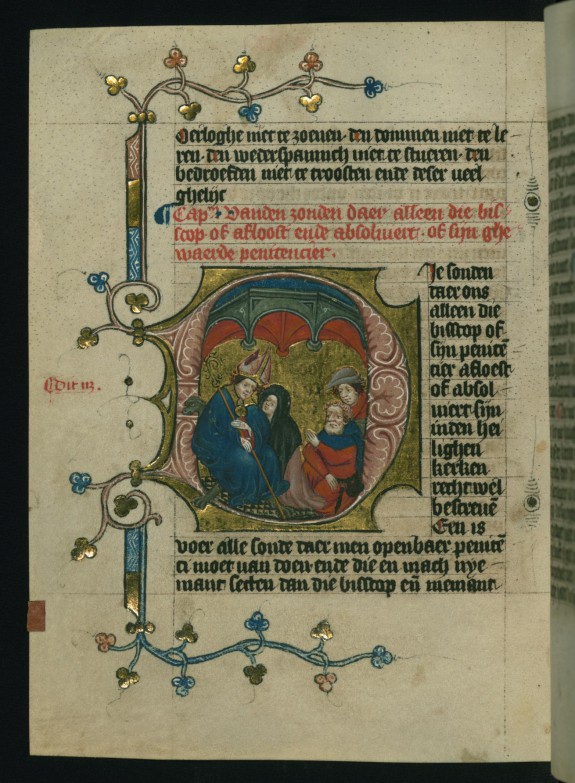Illuminated Manuscripts and Block Printing
Illuminated Manuscripts
Illuminated materials date back to as early as 500 CE. Before 1500 CE in Europe, all texts were hand-copied by scribes, usually monks in monasteries (University of Minnesota Libraries, n.d.); the term "Manuscript" comes from the latin manus (hand) and scriptus (to write) (De Hamel & British Museums 1992.) For special books, such as books for the clergy, pages could be decorated with thinly pressed gold and silver, elaborate lettering and brilliant coloring using materials such as arsenic, saffron, or red lead combined with the whites of eggs. These materials gave the book the ability to reflect light, giving the text the appearance of being "illuminated." The quality and size of the book was dependent on the subject of the book and the individual who was using the book. Paper used for these manuscripts would be parchment or vellum, types of paper made from animal skins. Papyrus was still in use during this time despite the fragility of the material (Dehamel & British Museums, 1992.) By 1400 CE, paper made from linen rags was one of the most common materials for bookmaking (DeHamel & British Museums, 1992.)

"Episcopal Confession Before a Bishop" (1400-1404) (Van Delft, 1400-1404.)
The creation of these manuscripts was most often done by monks in monasteries and most manuscripts were made for monastic collections, not for commercial sale to the public (DeHamel & British Museums, 1992.) Around 1200 CE the public demand for books grew exponentially, especially by universities and the public (DeHamel & British Museums, 1992). The earliest form of bookstore can be seen around 1250 CE and, in these institutions, patrons could buy second hand copies of books as well as commission their own illuminated books (DeHamel & British Museums, 1992.) A patron who commissioned a book from one of these stores would often receive their materials quicker than if it was hand-copied by a monk at a monastery (DeHamel & British Museums, 1992.); a monk might take years to complete a project whereas a commercial scribe may only take hours or days, most likely because they were paid by the project, not hourly (DeHamel & British Museums, 1992.)
Block Printing
Prior to Gutenberg's printing press, another early form of printing was called block printing. This process required the scribe to carve the page that was meant to be printed onto a wooden block, cover that block with ink, and then press or rub the block against paper to create the page (University of Minnesota Libraries, n.d.) While this method of printing did not come to Europe until around 1500 CE, block printing on silk in China dates back to before the time of Christ (Valentine, 2012.)
Woodblock for Printing-Yangzhou Museum (Vmenkov, 2021) - (CC BY-SA 3.0) (CC BY-SA 2.5) (CC BY-SA 2.0) (CC BY-SA 1.0)
Movable type (one piece of type for each character) was invented in 11th-century China, but failed to replace wood block printing due to its increased expense (Asia for Educators, n.d.) It is worth mentioning that, in 1234 CE, Korea would use metal movable type, a type of wood block printing using metal instead of wood, to print a large, multi-volume courtwork (Valentine, 2012.) While movable type was not widely adopted in China due to its additional expense, when movable type reached Europe in the 15th century, it would have a massive, multi-faceted impact for the masses of Europe (Asia for Educators, n.d.)
References
Asia for Educators (n.d.) Technological Advances during the Song. Columbia University.
http://afe.easia.columbia.edu/songdynasty-module/tech-printing.html
De Hamel, C. & British Museum (1992.) Scribes and illuminators. University of Toronto Press.
University of Minnesota Libraries (n.d.) 3.2: History of Books. University of Minnesota.
https://open.lib.umn.edu/mediaandculture/chapter/3-2-history-of-books/
Valentine, Patrick M. (2012). A social history of books and libraries from cuneiform to bytes. The Scarecrow Press, Inc.
Van Deft, D. (1400-1404). Episcopal Confession Before a Blessing [Illuminated Manuscript]. The Walters Art Museum.
https://art.thewalters.org/detail/81634/episcopal-confession-before-a-bishop/
Vmenkov, (2021). Yangzhou Museum - woodblock for printing - fragment [Image]. Wikimedia Commons
Additional Readings
-
The invention of printing in China and its spread westward byCall Number: 3rd Floor - General Collection (600-699) 655.151 C24iPublication Date: 1955
-
Pen and parchment : drawing in the Middle Ages byCall Number: AVAILABLE ONLINEPublication Date: 2009
-
Print culture and peripheries in early modern Europe : a contribution to the history of printing and the book trade in small European and Spanish cities byCall Number: AVAILABLE ONLINEPublication Date: 2013
-
-
Wood-Block Printing A Description of the Craft of Woodcutting and Colour Printing Based on the Japanese Practice byCall Number: AVAILABLE ONLINEPublication Date: 2006
